Constructing the Perfect ERAS Experience Section
Tips and tricks for the eras medical residency application.
So you’ve made it through your basic science curriculum and even survived your first year of clinical experiences! This is an exciting time in your medical education where you begin to look forward toward residency and that means yet another application. The good news is that the Electronic Residency Admissions Service (ERAS) looks a lot like your old friend the American Medical College Application Service (AMCAS). This means a familiar format of demographic information, educational background, experiences, and a personal statement. In this article we’ll focus on making sure your experiences section is top-notch!

Getting Started with ERAS – The Easy Part
ERAS breaks your experiences into 3 neat and easy categories which you’ll select from a drop-down menu: work, volunteer, and research experiences. You’ll need to include some basic information about the organization, your supervisor, and an estimate of your weekly hours amongst other items. You are allotted 1020 characters to describe the activity, and 510 characters to tell us why you left it. Let’s tackle that writing.
Description
1020 characters is a good block of space, so focus on about ¾ of that space devoted to a clear description about what you were doing, what role you played, and what you accomplished. Use a few sentences at the end to reflect on what you learned and what you took away from it. Keep in mind the whole time that you’re applying for a residency position – that means that lessons learned should be applicable to the practice of medicine at least, and hopefully specifically to your specialty of choice.
Why You Left
Applicants often struggle with this part, but there’s no trick question here. If you were engaged in a project and you completed it, well there you go. If you had more time to devote to an activity in years 1 and 2 but then needed more time for your clinical rotations in year 3, simply state it that way. You should not need to use up the character count for this unless there were special circumstances for walking away. Don’t overthink this one.
To Bullet or Not to Bullet
This is a common question amongst applicants. Should you write out your description in bullet form or paragraph form? I will tell you that I prefer the paragraph form but perhaps a better answer is that you can do both wrong. If you go with bullets, don’t make each bullet a paragraph. If you go with paragraph form, you need to use complete sentences. I prefer the paragraph form because you can be more reflective. Consider that most applicants will have many similar activities – like participating in an interest group for example. Let’s look at 2 approaches to illustrate a few advantages of the paragraph form:
Applicant A:
- Member of pediatrics interest group
- Participated in group meetings
- Attended lectures about pediatrics cases
- Volunteered at events for promoting interest group
Applicant B:
For 2 years now, I have been an active member of the pediatrics interest group. I attend group meetings to learn more about pediatrics, listen to lectures from pediatricians to get an up-close look at practicing pediatrics, and help promote the group. Not only have I formed strong friendships and collegial relationships with my fellow members, I have also had a chance to evaluate my own strengths and weaknesses and thoughtfully consider if pediatrics is the right specialty for me. The lessons learned from my membership have bolstered my performance on rotations and I hope will make me a stronger pediatrics resident in the future.
Notice there’s just so much more you can say with a paragraph. Suppose both applicants had the exact same resume and both chose bullet form. How would the program director decide which was a better applicant? Choosing to write in paragraph form allows you to identify and highlight all the unique aspects and attributes of your application, so as to help you stand out.
But Wait, There’s More!
ERAS breaks off publications as separate and has individual entry sections for the following items:
- Peer reviewed journal articles/abstracts
- Peer reviewed journal articles/abstracts (other than published)
- Peer reviewed book chapter
- Scientific monograph
- Other articles
- Poster presentation
- Oral presentation
- Peer-reviewed online publication
- Non-peer-reviewed online publication
These sections are relatively straight forward. You’ll be asked to fill in boxes for the title, the authors, editor, and other details. There are no spaces for description or reflection, so it’s just about listing what you’ve got.
Hopefully, this short article helps you sort out exactly what you’re up against with ERAS and how to make the most of the experience section. Make sure you double check your work for spelling and grammar issues and proof your application in PDF form before submitting!
Related posts:
- How to Be a Podiatrist
- Finding Mentors in Surgical Subspecialties
- Path to Residency Part 2: Learning How to Study
Sleep Medicine as a Specialty
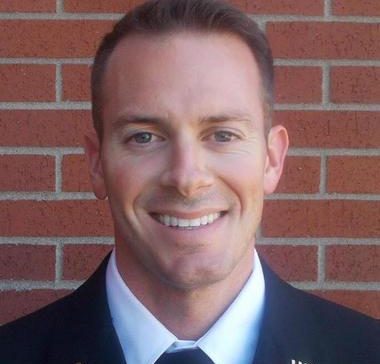
David Flick MD
Related articles.

Writing the Perfect Residency Personal Statement

2022 Physician Compensation Report

How to Do Well in Your Residency Interviews


Professionals
Tips for Preparing a Great ERAS Application in 2024
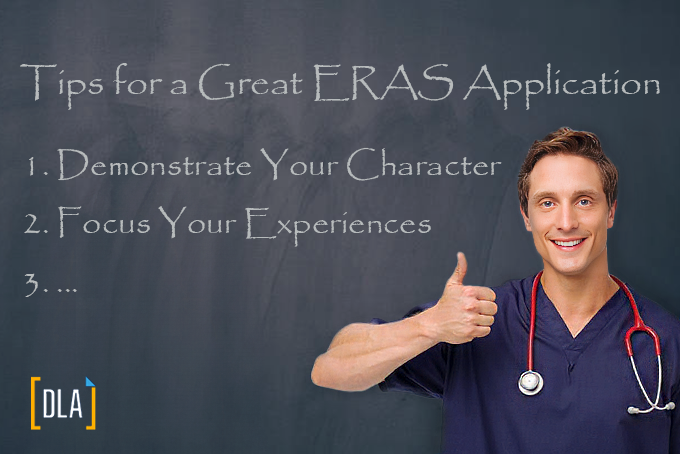
Written by David Lombardino | Updated June 5, 2024
15+ Years' Experience
With over 15 years’ experience in guiding candidates in applying for medical residency and fellowship , and having reviewed and edited 1,000+ ERAS Applications during that time, I have seen firsthand just how far the way in which you fill out your ERAS Application goes in communicating to program directors the kind of resident or fellow you would be in their programs.
Are you thorough in your work? Do you share insightful, well-considered details? Do you present yourself in a professional and welcoming manner?
Demonstrate Your Character
All these characteristics are ones you can demonstrate through how you fill out your ERAS Application. It communicates the kind of resident or fellow you will be, how you will fit into the program, and how you will approach meeting, diagnosing and caring for the program’s patients.
In this article, I will cover the details residency and fellowship applicants commonly overlook as well as answer common questions related to the ERAS Application.
After you’ve covered these basics, get our expert advice and recommendations on your ERAS Application by signing up for our ERAS Application Editing & Feedback service . The service comes with two rounds of review and can be completed in as little as two days.
Step 1: Use a Personal Email Address
One of the first items residency and fellowship programs will see is your email address. Are you providing your personal email address, one hosted by a common domain like gmail.com, hotmail.com or yahoo.com? Have you made sure to avoid using an email address with "dr" or "md" or something similar in it?
Following these recommendations will help you come across as personable and approachable.
For international applicants, when considering which email domain to use, make sure to select one that will provide reliable communication with programs in the U.S. Certain domains, like hanmail.com and qq.com, often experience issues when communicating with correspondents in the U.S.
Step 2: Make Your Mailing Addresses Spotless
The present and permanent mailing addresses is one place program directors look to see if there is a geographic connection to their programs. It is also the area most commonly left with basic, easy-to-fix errors by candidates when filling out the ERAS Application.
Take a moment to double-check them. Are they spelled, capitalized and punctuated correctly?
Step 3: Use Only a Mobile Phone Number
Ensure you list your mobile phone number as your Preferred Phone #, Permanent Address Phone # and Mobile #. If you have more than one mobile number, choose the one you are most likely to answer.
Step 4: Take Advantage of Hometowns
Hometowns represent an opportunity to list the places that have played a significant role in shaping you and your experience.
More importantly, they offer an opportunity to show geographic connection--if you have one--to where the program is located. Did you spend three years in Houston during middle school? List it to show your geographic connection to Baylor College of Medicine.
Include all such hometowns, even if it was not where you were born or where you live now.
Step 5: Consider Your Geographic Division Preferences Carefully
A quick look at the changes the AAMC made to the ERAS Application in 2023 shows easily the motivation behind them. Their aim is to get from candidates the information they find to be most relevant when deciding who to offer to interview.
This applies to geographic connection, a long-standing characteristic program directors have wanted to see and therefore a long-standing recommendation we have made for how to distinguish yourself in your personal statement. Whether you are married, own property or have close friends or family, we have long advised to make a tailored version of your personal statement to convey this information to relevant programs.
With the recent changes to the ERAS Application, you now have a second option for conveying this information--the census division.
The question is: Should you use it?
What Do Program Directors Want to See?
Program directors favor applicants with a personal connection to the program. Geographic connection is part of this. And with the 2023 changes, programs can now filter applications by geographic division. This doesn't necessarily mean they will.
If they do, then an advantage of stating a preference for the same census division as the program's will allow your application to pass the filter.
That said, if you are a compelling candidate for a program (e.g., you meet their minimum requirements for Step score), you should expect that most if not all the people interviewing you have read your personal statement. One program director I talked to said this is where she goes to see if there is a geographic connection.
She doesn't use the census division preference (e.g., the west coast) in ERAS because, she stated, it doesn't do enough to show specific geographic connection to her particular program.
When to State a Preference
If all the programs you are applying to fall within three U.S. Census regions, then it is to your advantage to state that preference and to provide a key, compelling reason for doing so.
The question is what to do if you are applying to programs outside those regions? If you state a geographic preference, then you lose the opportunity for communicating to those programs that you do not have a preference, that your reason is you prioritize quality of training over geography.
Step 6: Selected Experiences—The Header
Fill out Every Field
For each selected experience you list in your ERAS Application, provide as much information in the header for the experience as possible.
The “header” means the Organization, Experience Type, Position Title, Start Date, End Date, Country, State/Province, City, Postal Code, Participation Frequency, Setting, Primary Focus Area and Key Characteristics.
Completely fill out all fields for each experience—to the extent you can do so—even if the fields are not marked as required.
Be Comprehensive
Put as much contextual information as possible in the Organization and particularly the Position Title fields to remove the need to put it in the Context, Roles and Responsibilities description.
For example, for the Position Title, instead of just putting "Observer," put "Observer, Internal Medicine,” or put “Dept. of Medicine, Jones Hospital” instead of simply “Jones Hospital” for the Organization.
Step 7: Selected Experiences—Context, Roles and Responsibilities
Provide a Comprehensive Understanding of What You Did/Are Doing
When thinking of what to write, keep the descriptions focused on what you did. If describing a research experience, for example, do not talk about what the project or lead investigator was doing as something separate from you. Instead, describe what you did within that project.
Stick to the Facts
State what you did in the experience. Avoid ancillary commentary, for example, how much the experience inspired you to want to serve others. This will be reserved for your three Meaningful Experiences. Instead, here, state what you did, and let the facts speak for themselves.
Be Specific and Thorough
Be specific, concise and thorough. Have as your goal that the program director will have a comprehensive understanding of your experience from reading your description. Provide specific details and examples.
Use Sentence Fragments When Possible
Each item of your description should start with a past participle or present tense verb.
The exception to this is a description where it is necessary to write sentences with different subjects. In this case, write the subjects for the verbs to avoid confusion.
Choose Compelling Verbs
Since verb choice is key to a compelling description, make sure to use good ones. Avoid weak or vague verbs (e.g., worked). Instead, be as specific as possible about the actions you took or take in the experience.
Use Bullets
Use bulleted lists. Depending on what you need to convey, you can introduce the bulleted list with one or two full sentences to provide context, for example, if you want to provide an overview of a study you were involved in followed by a bulleted list of what you did for the study.
| |
Step 8: Focus Your Meaningful Experience Descriptions on the Key Characteristic
When considering which experiences to choose as "meaningful," it is important to consider the entire application. For example, is it okay for your meaningful experiences to overlap with what you write in your personal statement?
While you can certainly use one experience for a meaningful experience and in your personal statement, it is important to recognize that the focus is different, and it should therefore be used differently.
In the Meaningful Experience description, the focus should be on the Key Characteristic. How specifically did the experience challenge you, or did you grow in the experience, relative to the Key Characteristic you have selected for the experience? What was so impactful about the experience relative to the Key Characteristic?
For the personal statement, the primary question to answer is why this specialty? Where did this passion come from, and through what experiences was that passion reinforced, broadened, deepened or refined? When you use the experience in your personal statement, this, therefore, should be the focus of what you narrate there.
Step 9: Hobbies & Interests
Take a moment to think carefully about your Hobbies & Interests. Think of them as potential conversation topics for an interview. Choose no more than two or three, and make them interesting and worth noting by making them specific and comprehensive. For example, “Reading 19th-century Russian literature” is far more interesting than just “Reading.”
Step 10: Optional for Publications & Presentations
If you were to prepare your CV outside of ERAS, you may prefer to put your name in bold in the author list. The way to do this in ERAS is to put your name in ALL CAPS. If you do this for one presentation or publication, then, for consistency, do it for all presentations and publications.
However, this is personal preference. If you want to do this, you can. If you don't want to, that's just fine as well.
If you want to distinguish your titles, put them in ALL CAPS. If you do this for one presentation or publication, then, for consistency, do it for all presentations and publications.
This website uses cookies to improve user experience. By using our website you consent to all cookies in accordance with our Cookie Policy .
- (888) 381-9509
- [email protected]
- Book a Meeting
- student login
- Student Login
- Our Services
- Our Story How it started
- Our Team Meet Our Advisors & Tutors
- Our Services How we can help you
- Our Difference Learn why we stand out
- Success Stories & Testimonials Hear the stories
- For Parents Learn why you should trust us
- In the News Read Our Stories
- Frequently Asked Questions Find answers
- MCAT Tutoring One-on-One Personalized Help
- MCAT Go An Audio Learning Experience
- MCAT Practice Exams Boost Your Score
- MCAT Prep App Videos, Flashcards & Q-Bank
- MCAT CARS Mastery Top-Rated CARS Video Course
- Pre-Med Coach Early High School Roadmap Planning
- College Admissions 11th & 12th Grade Pre-Med Consulting
- Direct Med Advising BS/MD Application Support
- Interview Preparation BS/MD Candidates
- Pre-Med Coach Pre-Application Development
- Application Advising Med School Admissions Support
- Personal Statement Editing Refine Your Narrative
- AMCAS Editing Application Editing
- Secondary Editing Secondary Application Editing
- Interview Preparation Realistic Practice
- CASPer Preparation Simulation & Coaching
- Ontario Application Support OMSAS Application
- Residency Advising Complete Match Support
- Residency Interview Preparation
- ERAS Personal Statement Refine Your Story
- USMLE STEP 1 Pass Your First Step
- Shelf Exams Ace your rotations
- USMLE STEP 2 Shine on your boards
- USMLE STEP 3 Conquer your final hurdle
- COMLEX LEVEL 1 and 2 Score higher
- Institutional Partners Enhance your student offering
- Organizational Partners Provide value to your students
- For High School Students Plan Your Future
- For MCAT Preparation Boost Your Score
- For Med School Admissions Secure Your Acceptance
- For Board Exam Prep Sharpen Critical Knowledge
- For Residency Matching Secure Preferred Placement
- Extracurricular Activities Apply now!
- Guidebooks Learn at Your Own Pace
How to Expertly Fill out the ERAS Experiences Section
Posted in: Residency

Table of Contents
The Experiences Section is a big part of your ERAS (electronic residency application service), and some residency applicants find the sections and instructions somewhat confusing. But this section of the application is crucial for matching with your preferred program .
In 2024, the MyERAS Application service made major updates to this section , including:
- A limit of only 10 experiences (previously no limit)
- Space to describe the 3 “most meaningful experiences” from the list
- Specific experience types (to help “programs easily identify and review specific experiences that align with their mission(s)”)
- New options for mission-focused characteristics of each experience to define the setting, focus area, and key characteristic (designed to “showcase the mission-focused characteristics of the experience”)
- Multiple short descriptions for each experience: roles, responsibilities, and context (previously, this was just one “Experiences Description” field)
- Optional “Impactful Experiences” question (for applicants to “describe any challenges or hardships that influenced their journey to residency”)
I’m Sahil Mehta, M.D., and I’ve helped hundreds of med school students successfully make it into their ideal residency. Below, I break down the parts of this section and tips that I give students when filling out the ERAS Experiences Section (which includes considerations for the most recent changes).
Skip to the tips.
What Are the Parts of the Experiences Section?
The Experiences Section allows you to list up to 10 experiences or activities that you engaged in as a med school student or pre-med student (or, in some cases, as an undergrad ) that demonstrate your strength as a candidate for medical residency.
This section breaks up each experience into multiple parts:
- Type (category)
- Organization name
- Position title
- Start and end dates
- Primary focus area, if applicable
- Key characteristic developed or demonstrated, if applicable
- Description of the experience (1,020-character limit)
The description is arguably the most important piece because your writing must be interesting, professional, concise, and persuasive. You can find my suggestions for writing these descriptions later in this article.
Out of the 10 experiences, ERAS will ask you to choose your three most meaningful experiences. Under these three, you will write an additional description (up to 300 characters in length) explaining why these experiences impacted you most of all.
Read Next: A Guide to Supplemental ERAS Applications
Experience Types
Types are categories to better define what kind of experience you’re including. Residency programs understand that experiences can fall under more than type, but you must choose the one that best describes the experience or activity (you can’t select multiple categories).
You’ll be able to select from these experience types:
- Education/training (including clerkships, away rotations, subinternships, or structured observerships)
- Military service
- Professional organization (including at the local, regional, national, or international levels)
- Other extracurricular activity , club, hobby (including things like sports, music, theater, or student government)
- Teaching/ mentoring (including as a paid teacher, teaching assistant, or tutor)
- Volunteer/service/ advocacy (including unpaid experiences)
- Work (including paid clinical, nonclinical, business, or entrepreneurial experiences)
Primary Focus Areas
You can also list a primary focus for each experience. You may technically leave it blank, but I’d advise against that. Two or more focuses may apply to your experience, but you must choose only one. The types and primary focus areas overlap somewhat, but are used by program directors to organize information differently.
Here are the primary focus areas you can choose from:
- Basic science
- Clinical/translational science
- Community involvement/outreach
- Customer service
- Health care administration
- Improving access to health care
- Medical education
- Music/athletics/art
- Promoting wellness
- Public health
- Quality improvement
- Social justice/advocacy
Key Characteristics
I would recommend listing a key characteristic learned through each experience. You can leave it blank, but I would always try to choose one. Two or more may apply, but programs understand that you’re listing the characteristic that best describes what you learned.
Below are the key characteristics you’ll have to choose from:
- Communication
- Critical thinking and problem-solving
- Cultural humility and awareness
- Empathy and compassion
- Ethical responsibility
- Ingenuity and innovation
- Reliability and dependability
- Resilience and adaptability
- Self-Reflection and improvement
- Teamwork and leadership
It’s okay if your experience only occurred once, and it’s fine if you engage every week. Your residency application just wants to be clear on how often you have an “experience.”
Frequency types to choose from include:
- One time (not recurring)
- Daily (recurring) (more than two days a week)
- Weekly (recurring) (one or two days a week)
- Monthly (recurring)
- Quarterly (recurring)
- Annually (recurring)
Top Tips on Filling out the ERAS Experiences Section
I have helped hundreds of medical students with their residency applications. Don’t be stressed, MedSchoolCoach is here to help. Below, you can find my top tips for filling out the ERAS Experiences Section.
Get ERAS support from a Physician Advisor and join the 97% of MedSchoolCoach clients who match into US residency spots.
1. write the descriptions like this.
The description is the most important part of the Experiences Section. Give yourself plenty of time to work on these.
Try to answer the who, what, when, where, why, and how for each experience. The basic info included may answer the who, where, and when, but in the description you need to precisely describe:
- What — List your task(s) at this experience, your achievement(s) at this experience, what you learned.
- Why — Answer why did you engage in this experience, for what reason is it relevant to this application.
- How — Write how this experience demonstrated or developed characteristics that the program would find valuable, reflect how you grew.
All this must fit in only 1,020 characters. Not words, characters — that includes letters, spaces, and punctuation.
2. Write Your Most Meaningful Experiences Like This
Choose 3 of the 10 experiences to be your “most meaningful.” You get an additional 300 characters to explain why each of these is such an impactful experience.
Reflect on a “most meaningful experience” and explain why it was so impactful. Answer how it influenced you to be a stronger candidate for residency. Program directors are looking for descriptions that exemplify overcoming adversity, sophisticated introspection, and clear growth as a medical professional and as a human.
If you listed a key characteristic or primary focus area under a most meaningful experience, your 300-character description should explain why you chose that key characteristic or focus area.
WATCH: Standing Out on ERAS (Webinar)
3. Be Yourself
Programs don’t want just one type of applicant. They’re looking for a diverse range of candidates. Be true to yourself, and don’t make up or exaggerate experiences you think they want to hear.
What are you passionate about? Your passions should be evident through the Experiences Section. It’s okay if you talk about your dedication to the clarinet or to soccer or to a non-medical volunteer group, just make sure that it’s clear why this makes you a great candidate for a residency program.
4. Prioritize Relevant Work
Your number one priority is persuading the residency director that you are a good fit for that program. So, of course you should prioritize including your most relevant research, volunteering, extracurricular, and work experience in this section.
Often, any clinical experience you’ve done should be at the top of your Experiences Section. But this is where you can tailor your application toward your dream residency. If they’re highly involved in social justice, prioritize including your advocacy experiences. If they’re known for research, put your research experience at the top.
Read Next: Letter of Intent for Residency

5. Don’t Repeat Yourself
If you can help it, don’t repeat what you’ve already shown on other sections of the ERAS, such as the personal statement or letters of recommendation. Use the Experiences Section to complement the rest of your application.
There may be overlap, but focus on providing additional insight into your strength as a candidate wherever possible. In particular, your 300-character “most meaningful experiences” descriptions should not repeat information from the 1,020-character description, other activities, your MSPE Noteworthy Characteristics, or your well-crafted personal statement .
Learn More: Average Number of Residency Applications
6. Don’t Leave Blanks
Don’t leave optional fields blank if you can help it. According to an AAMC survey for the 2022/23 application cycle, about 55% of residency program directors said the “most meaningful experiences” helped them get a better picture of applicants. Around 35% used the key characteristics and primary focus areas to evaluate applications.
Also, try to fill out all 10 experiences. Although the quality of your experience descriptions is more important than the quantity or number of experiences, fewer than 10 experiences may indicate that you haven’t accomplished much or engaged with your community.
It might not make a huge difference if you have only 9 experiences, but just remember that the competition is fierce. Competitive residency applications utilize all the available space to their advantage.
7. Don’t Use Special Formatting
The ERAS application does not use rich formatting, so paragraph breaks, indentations, and bullet points may not translate correctly to the ERAS. Instead, write concise sentences in a single paragraph to avoid formatting errors.
I recommend using a basic text editor (like TextEdit on a Mac or Notepad on a PC), rather than MS Word or Google Docs, for drafting your descriptions and most meaningful descriptions.
8. Start As Early As You Can
Don’t force yourself to rush. Taking your time is best for everyone, and starting early allows you to take your time. Give yourself 4-6 weeks to brainstorm which experiences to include, how best to describe them, and which ones to make your “most meaningful.”
Remember: Start early on all ERAS sections, especially your LORs (letters of recommendation),, since LOR authors may need plenty of time and reminders.
9. Proofread a Lot
Any errors will decrease your chances of acceptance. Typos and grammatical errors put your communication skills and dedication to excellence into question. Triple-check your work. Use a free trial of Grammarly or ProWritingAid. Ask your family, friends, peers, and professors to proofread your Experience Section.
Should You Answer the Impactful Experiences Question?
One of the 2024 updates is the addition of the “Impactful Experiences” question . Here’s what AAMC has to say about it:
“Applicants can describe any challenges or hardships that influenced their journey to residency. This could include experiences related to family background, financial background, community setting, educational experiences, and/or general life experiences. This question is intended for applicants who have overcome major challenges or obstacles.”
56% of applicants responded to this question in 2023. If you are comfortable sharing the relevant personal details and have overcome obstacles on your path to becoming a doctor, then you should answer this question.
This is an optional question, used as part of the more holistic application review that the AAMC now encourages program directors to use during the residency application process.
Tread carefully: This question is meant to help residency programs understand significant challenges and hardships that have impacted an applicant’s journey. If you try to answer this question with an experience that did not actually present a significant challenge to you, you may come across as inauthentic or immature to those reading your answers.
To know if and how you should answer this question, consider the following:
- Have you experienced substantial financial difficulty in the process of affording your education to this point (including undergrad and medical school)? If so, how did this impact you, and what did you do to overcome these difficulties?
- Did you grow up in a community setting that doesn’t traditionally lend itself to success? If so, what about your community setting was challenging? The AAMC mentions food scarcity, crime, poverty, and lack of access to medical care as a few examples that may apply here.
- Have you struggled with limited opportunities throughout your education to connect with mentors or access resources that would have helped you succeed more easily? Describe what resources you didn’t have and how you dealt with this to pursue a medical career.
- Has anything you’ve encountered as part of your family situation made a large impact on your journey to becoming a physician? Have you lost a family member, served as a caregiver while pursuing your degree(s), or experienced a significant experience such as divorce? Are you the first in your family to graduate college? Discuss how these have shaped your pursuit of medicine.
Increase Your Chances at Matching with Your Dream Program
I know, we’re all trying to get the good news on Match Day . It takes a long time and hard work, but it’s doable. There’s no shame in asking for help. You’ve made it this far, now let’s take that next step on your journey to residency, together.
And when you get that residency interview , we offer coaching for that, too.
Join the 97% of MedSchoolCoach clients who match into US residency. Pair up with an expert Physician Advisor to strengthen your CV, craft a stand-out ERAS application, ace your interviews, and land a spot in your choice specialty.

Sahil Mehta MD
Dr. Mehta is the founder of MedSchoolCoach and has guided thousands of successful medical school applicants. He is also a practicing physician in Boston where he specializes in vascular and interventional radiology.
See How We Can Help
Search for:, recent posts, medschoolcoach, recent blog posts.

Table of Contents The Experiences Section is a big part of your ERAS (electronic residency application service), and some residency[...]
May 30, 2024

Letters of Intent for Residency Match: Process + How To Guide
Table of Contents The residency match process can be grueling — between away rotations, the endless ERAS application materials, tough[...]

A Guide to ERAS Supplemental Applications for 2023 Match Cycle
Table of Contents What is the Supplemental ERAS Application? What are the sections of the Supplemental ERAS Application? Which specialties[...]
September 15, 2022
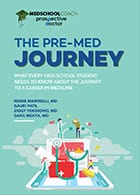
The Pre-Med Journey: What it Takes to Get into Medical School
Thinking about applying to medical school? Discover what high school students need to know about obtaining a career in medicine.
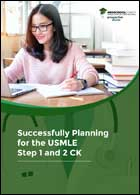
Successfully Planning for the USMLE Step 1 and 2 CK
Get ready for the USMLE Step 1 and Step 2 with this free guide to study planning and resource utilization.
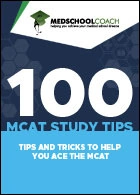
100 MCAT Study Tips
Taking the MCAT? These 100 tips and tricks will help you ace the MCAT.
Call us at (888) 381-9509
Call Us Now
Or, Schedule a Meeting Below
- Communities Pre-Med Medical Resident Audiology Dental Optometry Pharmacy Physical Therapy Podiatry Psychology Rehab Sci Veterinary
- What's new Trending New posts Latest activity
- Support Account Help Confidential Advising
- Vision, Values and Policies
- PreMed Communities
- Pre-Medical (MD)
Can you include oral presentations and posters presentations on ERAS if you weren't the presenter?
- Thread starter dsonic
- Start date May 23, 2020

Full Member
- May 23, 2020
A Gimlet Eye
- May 24, 2020
dwu12 said: ? Can you include oral presentations and posters presentations on ERAS if you weren't the presenter? Click to expand...
Similar threads
- Mar 15, 2024
- Johnwicksdog
- Apr 25, 2024
- thefloatingpanda
- Apr 17, 2024
- Jacob Saadoun
- Sep 27, 2023
- SquirrelsEverywhere
- May 31, 2022
- This site uses cookies to help personalize content, tailor your experience and to keep you logged in if you register. By continuing to use this site, you are consenting to our use of cookies and terms of service . Accept Learn more…
What to Know About Research on Your Residency Application

One of the things I didn’t know as a medical student, but wish I did earlier was how your research experience is displayed on your residency application. At the end of the day, this is the big goal we’re working on. So much of what we do in medical school is focused on boosting our residency application. Therefore, I wanted to share with you what you need to know about research on your residency application!
In its simplest form , research can be included on your application as:
- A research experience
- A research publication/presentation
The Research Experience
For each lab or PI, you will describe your research, your roles and the statuses of your projects. I’ve provided an example below. It’s up to you whether you want to write it in bullet points or paragraph form.
The Research Publication
In citation format, you will list your publications and poster/oral presentations. The format is predetermined and all you need to do is provide the publication information (e.g. authors, title, journal, page numbers).
Publication Section
Types of publications you can choose from:
- Peer-Reviewed Journal Articles/Abstracts
- Peer-Reviewed Journal Articles/Abstracts (Other than Published = Submitted/Accepted)
- Peer-Reviewed Book Chapter
- Scientific Monograph
- Poster Presentation
- Oral Presentation
- Peer-Reviewed Online Publication
- Non-Peer-Reviewed Online Publication
The most common ones you’ll use are bolded. In trying to maximize the number of publication, some students will include blog articles or podcasts as “Non-Peer-Reviewed Online Publication.” While I think it’s okay to do that, I would recommend filling up your application that way as it may come off as if you’re trying to fluff up your application.
- Include all published research papers plus any submitted or accepted manuscripts.
- A few months before ERAS, tie up loose ends on projects and get them submitted so you can include it on your application.
- Don’t double dip. If you listed your poster presentation as a presentation, don’t also list it as a published abstract.
- If you have a project you’re working on that is not submitted, mention it in your research experience section.
- Be able to intelligently speak about any research project listed with your interviewers.
Want more in-depth information? Check out this forum on SDN .
Check out these popular posts!
2024-2025 ultimate eras residency application guide, leave a reply cancel reply.
Your email address will not be published. Required fields are marked *
Save my name, email, and website in this browser for the next time I comment.
Website URL
MORE POSTS FOR YOU
The ideal learning method for crushing usmle step exams, honest review: md glam – science backed skincare by dr. cat, plastic …, clinical attire: must-have affordable sweaters for 2021.
Get the Reddit app
/r/medicalschool is an international community for medical students
Do Grand round presentations count as an "oral presentation" on ERAS?
Not to stress anyone out last minute, but I saw something about this online from years ago. What's the consensus right now?
By continuing, you agree to our User Agreement and acknowledge that you understand the Privacy Policy .
Enter the 6-digit code from your authenticator app
You’ve set up two-factor authentication for this account.
Enter a 6-digit backup code
Create your username and password.
Reddit is anonymous, so your username is what you’ll go by here. Choose wisely—because once you get a name, you can’t change it.
Reset your password
Enter your email address or username and we’ll send you a link to reset your password
Check your inbox
An email with a link to reset your password was sent to the email address associated with your account
Choose a Reddit account to continue

IMAGES
VIDEO
COMMENTS
If you gave a (poster or oral) presentation at a conference, and the abstract corresponding to your presentation was subsequently published in a peer-reviewed journal ... ERAS 2011 has specified loads of categories for publications, i.e. non-peer reviewed, non-published, online publication and other articles etc. ...
I would personally discard any application that I saw this on. It is clearly padding and not in the spirit of what an oral research presentation is. That section is for actual presentations or posters at actual conferences. If you want to put those small talks on your CV as an attending, that's fine, but it's not what should be on ERAS.
This video provides step-by-step guidance on how to fill the publications portion of your ERAS application including important tips regarding peer reviewed j...
Poster presentation. Oral presentation. Peer-reviewed online publication. Non-peer-reviewed online publication. Other articles. Publications follow AMA format and are ordered by type of publication according to the order above and then by the author last name in ascending alphabetical order. If you do not have an entry, you must select None.
ERAS 'oral presentations'. This forum made possible through the generous support of SDN members, donors, and sponsors. Thank you. I held two oral presentations at national/regional meetings. My presentations were on work that I had done in the lab and I listed them under 'oral presentations'. However, a resident in my lab also presented at some ...
ADMIN MOD. Oral presentation in publications section of ERAS. I've a bunch of oral presentations done on various community outreach programs, and patient awareness camps. I don't have specific certificates to show for them though, since they were small scale events (50-10 attendees) predominantly focusing on patient education.
Posters and Oral Presentations. As a graduate student your first opportunity to formally present your research (beyond your lab/institution) will be at regional and/or national scientific meetings via poster and/or oral presentations. Attending such meetings is an important part of your professional development; you will see and hear ...
Top 5 ERAS Points. Hit "Save" all of the time, and proofread. View your ERAS application in both CV and "application" formats. Print your Assignment Report and make sure you assigned all your documents. Remember to click the final "Certify and Submit" button between September 5-15, and have your credit card ready!
ERAS breaks your experiences into 3 neat and easy categories which you'll select from a drop-down menu: work, volunteer, and research experiences. You'll need to include some basic information about the organization, your supervisor, and an estimate of your weekly hours amongst other items. You are allotted 1020 characters to describe the ...
Step 10: Optional for Publications & Presentations. If you were to prepare your CV outside of ERAS, you may prefer to put your name in bold in the author list. The way to do this in ERAS is to put your name in ALL CAPS. If you do this for one presentation or publication, then, for consistency, do it for all presentations and publications.
Oral presentations on ERAS. I was a licensed mental health provider before medical school and I have given presentations for small orgs that were legit lectures, but not to the fanciest academic crowds.
Meet with your FSA to review ERAS, PS and program lists LORs-How to ask for LORs? Start of the rotation, End of rotation? Send Dr. Ananthakrishnanand Fatima Chaudhry by Friday August 20th: - Eras letter request form - CV, Draft PS and ERAS ERAS deadline on Wednesday September 29, 2021 (Sept 19thfor the supplemental application)
Give yourself 4-6 weeks to brainstorm which experiences to include, how best to describe them, and which ones to make your "most meaningful.". Remember: Start early on all ERAS sections, especially your LORs (letters of recommendation),, since LOR authors may need plenty of time and reminders. 9. Proofread a Lot.
First author on oral presentations is the presenter and that's generally understood. Where it looks like inflation and gets sticky is when you list the oral and the poster and the published abstract and the eventual paper* [In Preparation]*... unless these are major conferences then I would avoid it. hierarchy: paper > abstract > oral ~> poster.
Experience. For the 2025 ERAS season, residency and fellowship applicants may share more about themselves with programs. You can select and categorize up to 10 experiences and describe up to three of these experiences as your most meaningful. If you have overcome major obstacles before or during medical school, you may share them in the ...
ERAS 2023ERAS Residency application fees are based on the total number of programs per specialty applied to within an ER. S season. MyERAS will automatically calculate processing fees, tax where applicable, and collect payment information for valid Visa, MasterCard, American Express, or Discover credit cards before programs are a.
Publications-> oral presentations. Was not going to include it under research experiences. 1. Reply. Brocystectomi • 1 yr. ago. That's also what I meant; it's not research / a pub so I don't think it should be listed as such. I would put it under experiences for sure though. that's just my opinion and I could be wrong, but this is how ...
If an abstract is accepted to a meeting, especially as an oral presentation, it speaks to the relevance and quality of the research. ... List the project under "Oral Presentations" in ERAS and put (presenter) after the name of the person that gave the actual talk. Do the same with poster presentations in which you were involved but did not ...
Include all published research papers plus any submitted or accepted manuscripts. A few months before ERAS, tie up loose ends on projects and get them submitted so you can include it on your application. Don't double dip. If you listed your poster presentation as a presentation, don't also list it as a published abstract.
Thats not what oral presentations mean for eras. You can add that description in your rotation part for those clerkship. Those arent oral presentations meant for pubs. PDs would roll their eyes at you if you do that. Reply. starkrish PGY-1 •. Additional comment actions. Oral presentations meant - Oral Presentation at Professional society ...
ERAS® Applicant Worksheet (continued) If yes, NRMP ID: • If you are already registered for the NRMP Match and have your NRMP ID, please enter it. • If you currently do not have your NRMP ID, please enter it as soon as you receive it. NRMP ID is not required to certify & submit your application and can be added once you have received your ...
I found some recommendations by med schools regarding this. Basically, if a poster is presented without you, you can put it in Eras and designate the speaker. If an abstract is published and presented by someone else, you can put it in eras. If an abstract is presented by someone else and not published, you cannot put it in eras.
In front of how many people? I have no idea what the consensus is, but if you have a good presentation in front of a whole department and grand rounds you might be able to throw that on there as a presentation (educational, not research)